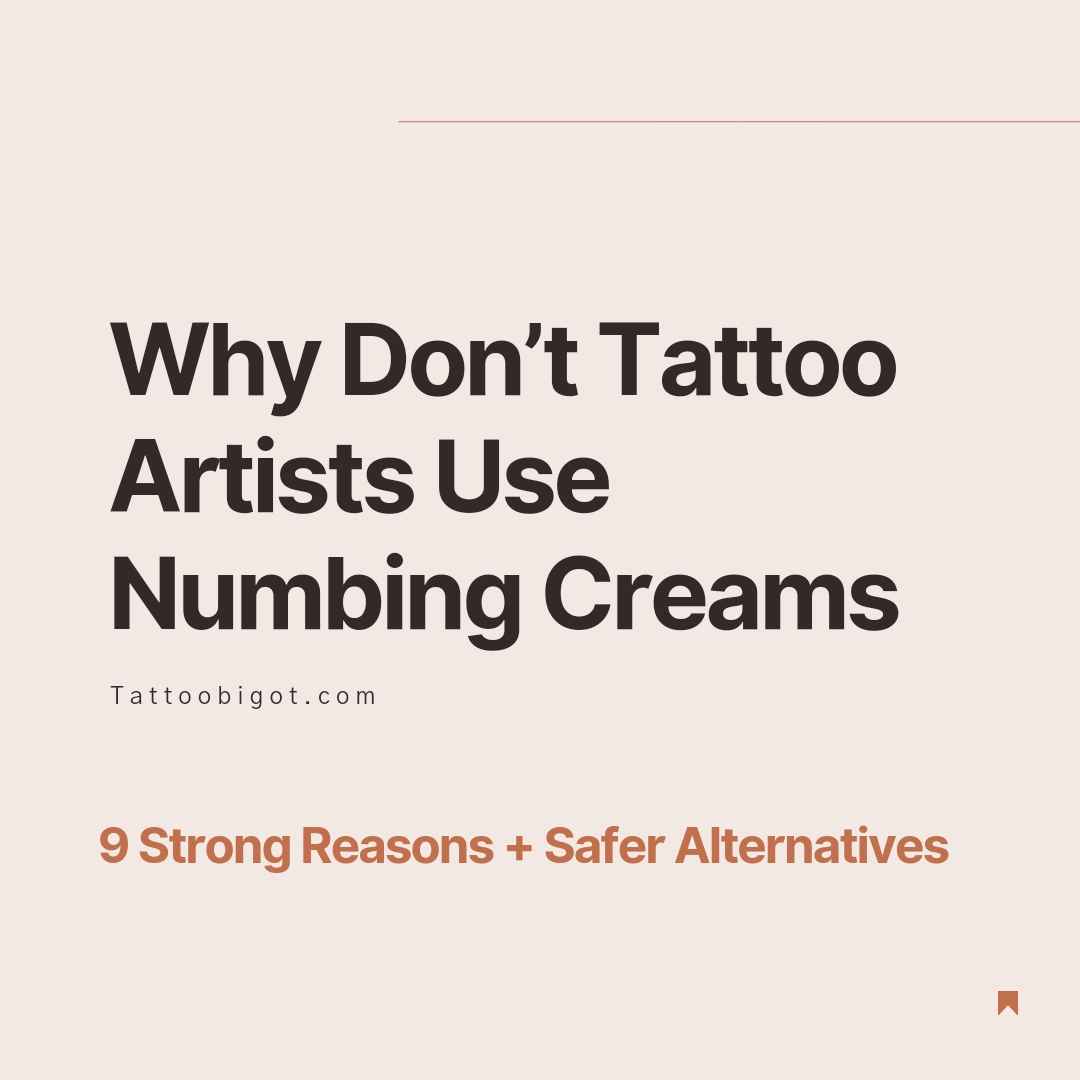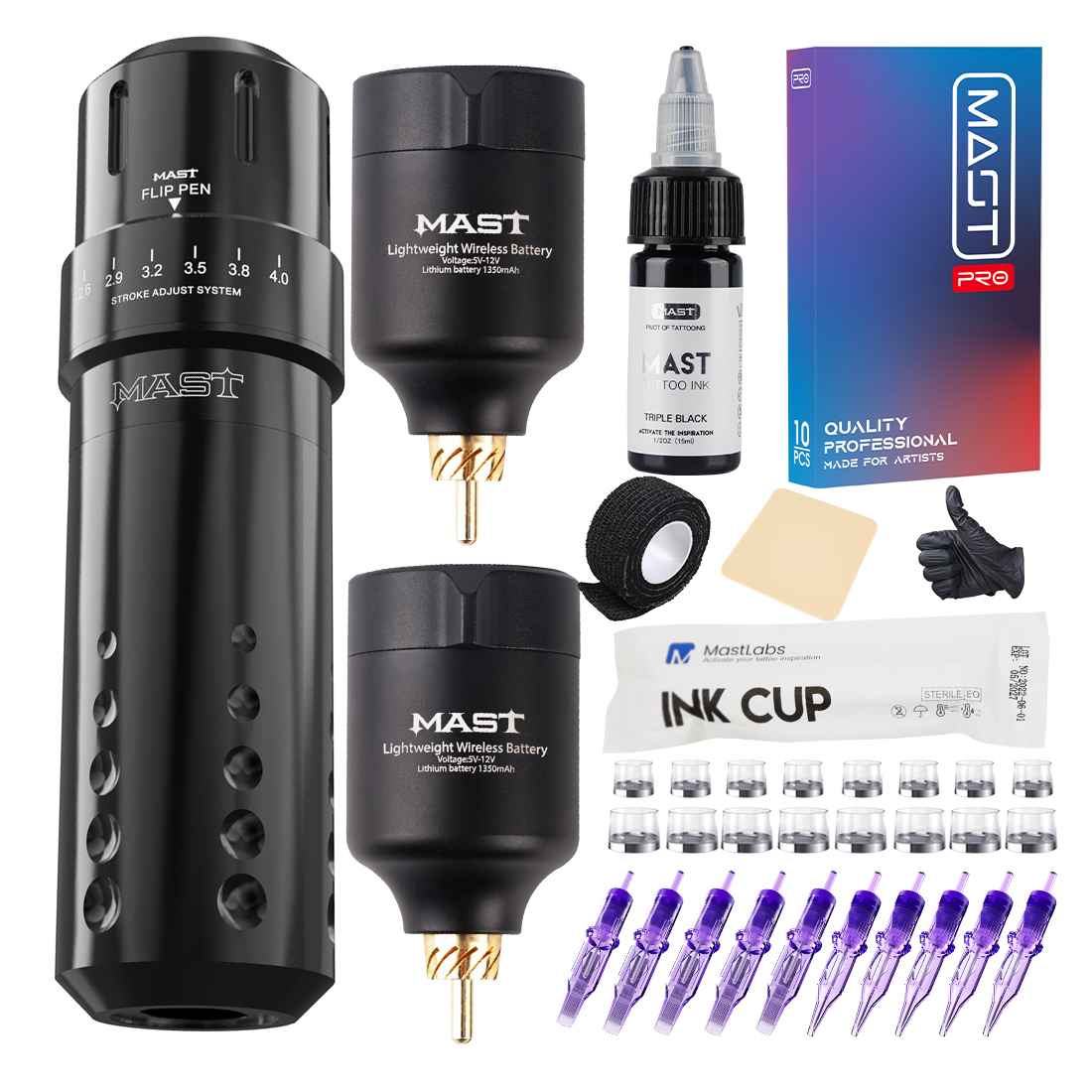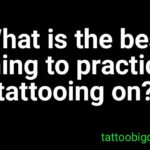Imagine the exhilarating blend of anticipation and excitement as you step into a tattoo parlor, ready to etch a permanent masterpiece onto your skin.
The buzzing sound of the tattoo machine echoes in your ears, and your nerves tingle with a mix of thrill and apprehension.
Now, picture a world where the pain of the tattooing process is merely a whisper, drowned out by the soothing embrace of numbing creams.
Why don’t tattoo artists use numbing creams, this seemingly magical solution, you might wonder? These topicals seem like an easy solution to take the sting out of getting tattooed.
However, most professional tattoo artists discourage numbing creams. They avoid using them for legitimate reasons beyond just wanting clients to “tough it out.”
Numbing creams carry risks and can undermine the tattoo process in several ways. In this exploration, we will unravel the intriguing reasons behind the tattoo industry’s decision to bypass numbing creams, read on.
Why Don’t Tattoo Artists Use Numbing Creams
Get inked is a painful process, using numbing creams seems like the go-to soliton to dealing with the pain, still many tattoo artists won’t allow you use numbing creams. Why? These are the reasons;
1. Numbing Creams Interfere With Artist’s Work
Numbing creams change how skin looks and responds during tattooing. They distort skin texture, circulation, and color.
This impairs artists’ ability to assess their work in progress. The numbed skin reacts differently to needle penetration.
Artists lose tactile feedback needed to properly gauge depth, pressure, and technique. Using numbing creams makes it harder for them to create quality, consistent tattoos.
2. Tattoo Numbing Creams Pose Health Risks
Numbing agents in tattoo creams can provoke allergic reactions, skin irritation, rashes, and other problems. Numbing effects may mask symptoms of underlying issues.
And deep numbness could allow artists to inadvertently penetrate too far and cause internal damage. Improper application also risks overdosing.
In rare cases, numbing agent toxicity has caused seizures, heart attacks, or other life-threatening reactions.
This why you should use only the best tattoo numbing creams that are highly recommended by top tattoo artists all over the world.
3. Topicals Create a False Sense of Security
Many clients assume numbing creams will eliminate all discomfort. When some pain inevitably remains, people feel mislead.
Numbing effects are also inconsistent. Numbness wears off unevenly across a tattoo site. This leaves clients unprepared for sudden sharp sensations. Partial numbing can aggravate rather than ease discomfort.
Also Read: Can a Veterinarian Have Tattoos? Here’s the Honest Truth
4. Tattoo Numbing Creams Contain Potentially Addictive Ingredients
Certain numbing creams use ingredients related to opioid drugs. While low risk in limited use, routinely relying on these creams risks developing dependence and addiction.
Their method of administration via skin also makes precise dosing difficult. This opens the door to misuse and abuse of the numbing ingredients.
Also Read: Top 17+ Tattoo Numbing Creams for a Painless Tattoo Session Experience
5. Tattoo Numbing Creams May Result in Poor Tattoo Aftercare
Numbing cream residues left in new tattoos can interfere with proper healing.
Artists also can’t accurately instruct aftercare since clients didn’t experience normal levels of inflammation.
Besides these points, numb skin makes clients less cautious about caring for tender new tattoos. This leads to suboptimal aftercare compliance.
Also Read: Why Do They Ask If You Have Tattoos Before Surgery?
6. Tattoo Numbing Creams are Illegal Without Prescription
Many numbing creams contain ingredients only legal with a doctor’s prescription. Using them for tattooing is unapproved “off-label” use.
Shops that provide the creams are dispensing controlled substances illegally. Clients also violate laws by using prescription anesthetics without a script.
7. Numbing Creams Create Logistical Headaches
Numbing creams must be applied in advance and covered with plastic wrap to penetrate fully. This adds steps that slow down artists’ workflow.
The wrap disrupts stencil application and artists’ access to the skin. Numbing timing can also mismatch with peak effects wearing off mid-session. It burdens artists with added hassles.
8. Ethical Concerns
Some artists view relying on numbing creams as “cheating.” They believe embracing the full experience offers greater rewards.
Numbing seems like an easy way out that shortcuts personal growth. For artists who see tattooing as transformative, numbing creams undermine that philosophy.
Also Read: Why Do Tattoo Artists Wear Black Gloves: [9 Secrets of Tattoo Perfection]
9. Clients Feel Ripped Off
Adding numbing steps extends appointment times but barely decreases billable hours.
Yet clients expect a discount since “the artist didn’t have to do as much work.”
When billed the full rate, clients unfairly feel overcharged. This breeds resentment even if the pricing rationale makes sense.
Why Do Some Tattoo Artists Use Numbing Creams?
Alright, alright, I won’t be a spoilsport by talking about the downsides of tattoo numbing creams which makes many tattoo artists not use.
Given all these drawbacks, some tattoo artists still do use numbing creams.
So, why do some artists incorporate numbing creams?
Reasons may include:
- Accommodating lower pain tolerance clients
- Appeasing client demands despite misgivings
- Working on extremely painful areas
- Providing comfort for long marathon sessions
- Temporarily numbing irritable skin conditions
- Making clients relax and sit still if highly anxious
However, reputable artists use alternative pain control methods whenever feasible.
They reserve numbing creams only for select challenging circumstances. Artists focus on making the experience as positive and effective as possible, with or without numbing.
What Are Safer Alternatives to Numbing Creams?
These options avoid the pitfalls of numbing creams while still easing discomfort:
Topical anesthetics – Over-the-counter numbing sprays absorbed through the outer skin. Effects are milder and safer.
Cold therapy – Icing before and after sessions decreases inflammation and swelling.
Vibrations – Buzzing tattoo machines diffuse and distract from pain signals.
Frequent breaks – Short pauses let adrenaline rebound to ease discomfort.
Conversation – Talking provides distraction and releases tension.
Calming music – Soothing tempos and vocal harmonies promote relaxation.
Comfortable position – Proper arm, leg, or body positioning avoids cramps.
Clenching fist – Tightening and releasing muscles stimulates natural endorphins.
Mental focus – Using meditation techniques zones out physical sensations.
With some preparation and resilience, tattoo pain can be overcome without risky numbing creams.
Conclusion
In this article, we’ve looked out the question, “Why don’t tattoo artists use numbing creams?”
In the article it became clear that in most situations, numbing creams during tattoo sessions create more problems than they solve.
Legal issues, health risks, effects on artists’ work, and other concerns make numbing agents problematic.
However, artists recognize certain specialized circumstances may warrant their cautious use.
Clients should have an open conversation with their artist about discomfort management ahead of time.
With shared understanding, artists and clients can find the right balance to create a safe, productive tattooing experience.
FAQ About Tattoo Numbing Creams
Should I apply numbing cream before arriving for my appointment?
No, only apply it at the studio right before your session. Using it prematurely risks wasting effects before tattooing starts. Let your artist handle application to ensure proper technique.
How long before my appointment should numbing cream be applied?
Application should begin 45-60 minutes prior for optimal effect. But consult your artist, as timing depends on the specific numbing cream and your skin’s responsiveness. Avoid applying too early and wasting duration of effects.
Do numbing creams eliminate all tattoo pain?
No, numbing creams only reduce discomfort. The intensity and effectiveness of numbness varies. Your pain experience also depends on personal factors like tattoo location, content, size, and your individual pain tolerance. Some discomfort is still likely.
Are there OTC numbing sprays or gels I can use without my artist?
Only under your artist’s supervision. Mild topical anesthetics may be safer, but require proper application. Never use prescription, addictive, or unapproved numbing substances without your artist overseeing use.
Will using numbing cream damage my tattoo results?
It shouldn’t if used sparingly under your artist’s guidance. However, extensive reliance on numbing can distort an artist’s technique and vision. Prioritize the long-term appearance and quality of your tattoo over temporary pain avoidance.






